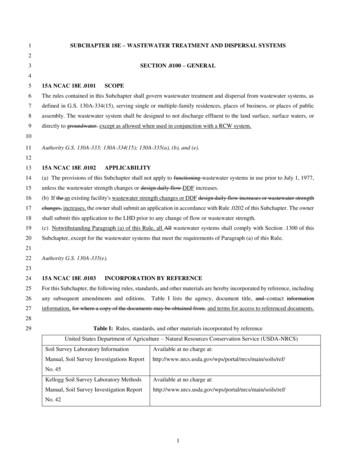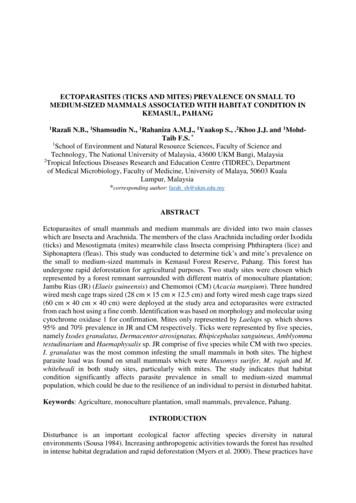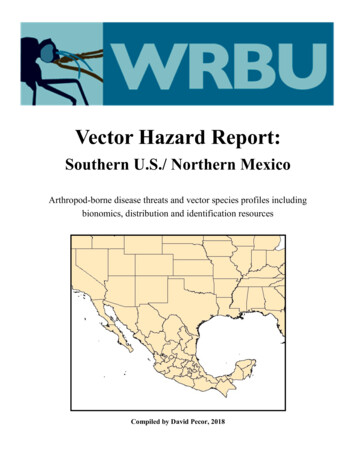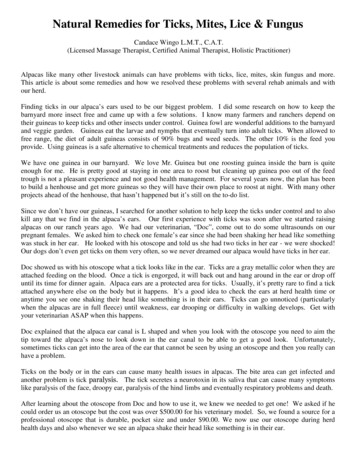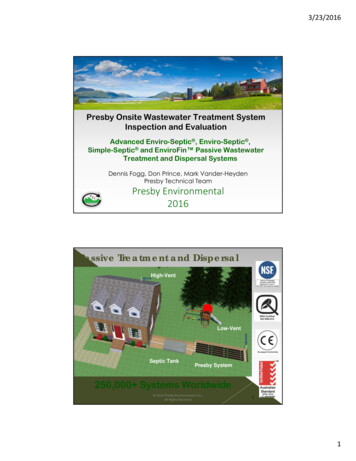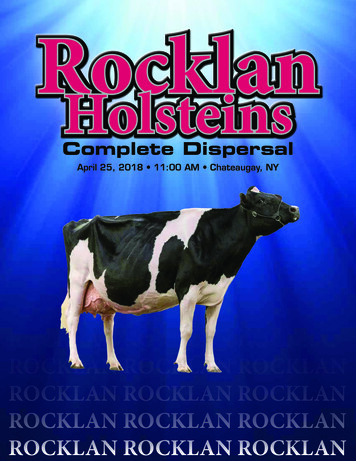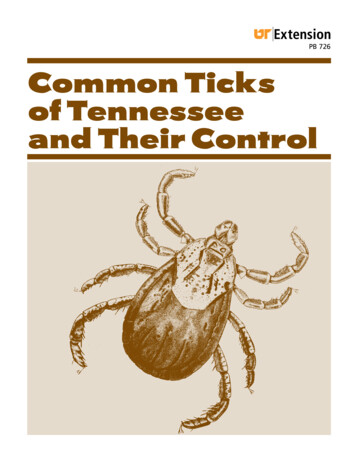
Transcription
Digital Comprehensive Summaries of Uppsala Dissertationsfrom the Faculty of Medicine 1794Dispersal of ticks and theirmicroorganisms by AfricanWestern Palaearctic migratorybirdsTOVE HOFFMANACTAUNIVERSITATISUPSALIENSISUPPSALA2021ISSN 1651-6206ISBN 978-91-513-1352-8URN urn:nbn:se:uu:diva-458872
Dissertation presented at Uppsala University to be publicly examined in Sal X,Universitetshuset, Biskopsgatan 3, Uppsala, Wednesday, 26 January 2022 at 14:00 for thedegree of Doctor of Philosophy (Faculty of Medicine). The examination will be conductedin English. Faculty examiner: Associate professor Johan Normark (Department of ClinicalMicrobiology, Umeå University).AbstractHoffman, T. 2021. Dispersal of ticks and their microorganisms by African-WesternPalaearctic migratory birds. Digital Comprehensive Summaries of Uppsala Dissertationsfrom the Faculty of Medicine 1794. 90 pp. Uppsala: Acta Universitatis Upsaliensis.ISBN 978-91-513-1352-8.In Europe, tick-borne diseases are the most widespread and common vector-borne diseases andtheir geographical distribution is increasing. The dispersal of ticks depends on the movementsof their vertebrate hosts. Avian hosts are more likely to be involved in long-distance rangeexpansion of ticks due to their migration pattern. Billions of birds in the African-Palaearcticmigration system migrate biannually between breeding grounds in the Palaearctic and winteringgrounds in Africa and thereby create natural links between Africa, Europe, and Asia. In thisthesis the dispersal of ticks and their microorganisms by northbound migratory birds utilizingflyways in the African-Western Palaearctic region has been investigated and the associationbetween bird ecology and tick taxon addressed. The results suggest that long-distance migratorybirds with wintering regions in Africa are involved in northward dispersal of the tick speciesHyalomma rufipes, a known vector or Crimean-Congo hemorrhagic fever virus, and that birdswith an open or wetland habitat have more H. rufipes in comparison to birds with a winterhabitat comprising forest and shrubs. The results also suggest a role for birds in the ecologyof Alkhurma hemorrhagic fever virus, a hemorrhagic flavivirus, and a potential mechanism fordispersal of the virus to new regions, including Europe and Asia Minor. The results did notprovide evidence for immature ticks of the Hyalomma marginatum complex and birds having amajor role in the ecology and northward dispersal of tick-borne Anaplasma phagocytophilum,a zoonotic bacterium causing febrile illness in humans and domestic animals. However, theresults give support to the idea of a divergent enzootic cycle of A. phagocytophilum involvingbirds as hosts. Finally, the results of this thesis suggest that H. rufipes do not serve as vectorsor contribute to the transmission of the tularemia-causing bacterium Francisella tularensis andthat migratory birds do not contribute to northward dispersal of F. tularensis-infected ticks.However, the results suggest that migratory birds contribute to northward dispersal of H. rufipescarrying both Francisella and spotted fever group Rickettsia species, including Francisellalike endosymbionts and Rickettsia aeschlimannii. In conclusion, this thesis helps to clarifythe knowledge about the dispersal of ticks and the microorganisms they carry by northboundmigrating birds in the African-Western Palaearctic region. Furthermore, it highlights the needof establishing surveillance programs for monitoring the risk of introduction and establishmentof important exotic tick species, such as H. rufipes, and tick-borne pathogens in the WesternPalaearctic.Keywords: African-Western Palaearctic, migratory birds, Ixodidae, Hyalomma rufipes, Ixodes,Alkhurma hemorrhagic fever virus, Anaplasma phagocytophilum, Francisella, Midichloria,Rickettsia aeschlimannii, PCR, microfluidic qPCR, metagenomicsTove Hoffman, Department of Medical Sciences, Department of Medical Biochemistry andMicrobiology, Box 582, Uppsala University, SE-75123 Uppsala, Sweden. Tove Hoffman 2021ISSN 1651-6206ISBN 978-91-513-1352-8URN urn:nbn:se:uu:diva-458872 (http://urn.kb.se/resolve?urn urn:nbn:se:uu:diva-458872)
Till min son LeonInget i livet är viktigare än du.Jag älskar dig till månen och tillbaka igen - oändligt många gånger.
List of PapersThis thesis is based on the following papers, which are referred to in the textby their Roman numerals.IIIIIIIVHoffman, T., Carra, L.G., Öhagen, P., Fransson, T., Barboutis,C., Figuerola, J., Kiat, Y., Onrubia, A., Jaenson, T.G.T.,Nilsson, K., Lundkvist, Å., and Olsen, B. Association betweenguilds of birds in the African-Western Palaearctic region andthe tick species Hyalomma rufipes, one of the main vectors ofCrimean-Congo hemorrhagic fever virus. One Health, 2021.13:100349.Hoffman, T., Lindeborg, M., Barboutis, C., Erciyas-Yavuz, K.,Evander, M, Fransson, T., Figuerola, J., Jaenson, T.G.T, Kiat,Y., Lindgren, P-E, Lundkvist, Å., Mohamed, N., Moutailler, S.,Nyström, F., Olsen, B., and Salaneck, E. Alkhurmahemorrhagic fever virus RNA in Hyalomma rufipes ticksinfesting migratory birds, Europe and Asia Minor. Emerg InfectDis, 2018. 24(5):879-882.Hoffman, T., Wilhelmsson, P., Barboutis, C., Fransson, T,Jaenson, T.G.T., Lindgren, P-E., Von Loewenich, F.D.,Lundkvist, Å., Olsen, B. and Salaneck, E. A divergentAnaplasma phagocytophilum variant in an Ixodes tick from amigratory bird; Mediterranean basin. Infect Ecol Epidemiol,2020. 10(1):1729653.Hoffman, T., Sjödin, A., Öhrman, C., Karlsson, L.,McDonough R.F., Sahl, J.W., Wilhelmsson, P., Pettersson,J.H.-O., Barboutis, C., Figuerola, J., Onrubia, A., Kiat, Y.,Piacentini, D., Jaenson, T.G.T., Lindgren, P-E., Moutailler, S.,Fransson, T., Forsman, M., Nilsson, K., Lundkvist, Å., andOlsen, B. Co-occurrence of Francisella and spotted fever groupRickettsia in avian-associated Hyalomma rufipes. Manuscript.Reprints were made with permission from the respective publishers.
Additional PublicationsPublications not included in the thesis:Hoffman, T., Kolstad, L., Lindahl, J.F., Albinsson, B., Bergqvist, A.,Rönnberg, B., and Lundkvist, Å. Diagnostic potential of a Luminex-basedCoronavirus Disease 2019 Suspension Immunoassay (COVID-19 SIA) for thedetection of antibodies against SARS-CoV-2. Viruses, 2021. 13(6):993.Hoffman, T., Kolstad, L., Rönnberg, B., and Lundkvist, Å. Evaluation ofproduction lots of a rapid point-of-care lateral flow serological test intendedfor identification of IgM and IgG against the N-terminal part of the spikeprotein (S1) of SARS-CoV-2. Viruses, 2021. 13(6):1043.Krambrich, J., Akaberi, A., Ling, J., Hoffman, T., Svensson, L., Hagbom, M.,and Lundkvist, Å. SARS-CoV-2 in hospital indoor environments ispredominantly non-infectious. Virol J, 2021. 18(1):109.Nissen, K., Hagbom, M., Krambrich, J., Akaberi, D., Hoffman, T., Sharma,S., Ling, J., Svensson, L., Bondesson, K., and Salaneck, E. Presymptomaticviral shedding and infective ability of SARS-CoV-2; a case report. Heliyon,2021. 7(7):e06328.Nissen, K., Krambrich, J., Akaberi, D., Hoffman, T., Ling, J., Lundkvist, Å.,Svensson, L., and Salaneck, E. Long-distance airborne dispersal of SARSCoV-2 in COVID-19 wards. Sci Rep, 2020.10:19589.Lindahl, J.F., Hoffman, T., Esmaeilzadeh, M., Olsen, B., Winter, R., Amer,S., Molnár, C., Svalberg, A., and Lundkvist, Å. High seroprevalence of SARSCoV-2 in elderly care employees in Sweden. Infect Ecol Epidemiol, 2020.10(1).Langenwalder, D.B., Schmidt, S., Silaghi, C., Skuballa, J., Pantchev, N.,Matei, J.A., Mihalca, A.D., Gilli, U., Zajkowska, J., Ganter, M., Hoffman, T.,Salaneck, E., Petrovec, M., and von Loewenich, F.D. The absence of the drhmgene is not a marker for human-pathogenicity in European Anaplasmaphagocytophilum strains. Parasit Vectors, 2020. 13:238.
Lindahl-Rajala, E., Hoffman, T., Fretin, E., Godfroid, J., Sattorov, N.,Boqvist, S., Lundkvist, Å., and Magnusson, U. Detection and characterizationof Brucella spp. in bovine milk in small-scale urban and peri-urban farmingin Tadjikistan. PLoS Negl Trop Dis, 2017. 11(3): e0005367.Hoffman, T., Rock, K., Mugizi, DR., Muradrasoli, S., Lindahl-Rajala, E.,Erume, J., Magnusson, U., Lundkvist, Å., and Boqvist, S. Molecular detectionand characterization of Brucella species in raw informally marketed milk fromUganda. Infect Ecol Epidemiol, 2016. 6:10.3402/iee.v6.32442.
ContentsIntroduction. 17Zoonotic diseases . 17Vector-borne infections. 17Bird biology and ecology . 18Migration and stopover ecology . 18The African-Palaearctic migration system . 19Birds as hosts . 19Tick taxonomy, biology, and ecology . 20Tick taxonomy . 20Life cycle of Ixodidae ticks . 20Feeding preferences . 21Dispersal mechanisms . 21Vector competence . 22Tick-borne diseases . 22Hyalomma marginatum species complex. 22Ixodes ricinus species complex . 26Tick-borne microorganisms . 26Arboviruses. 26Intracellular tick-borne bacteria . 29Endosymbionts of ticks . 32Co-infections . 33The Mediterranean basin tick project. 33Aims . 35General aim . 35Specific aims . 35Study I . 35Study II . 35Study III . 35Study IV. 35Materials and Methods . 37Collection sites . 37Maps . 38Ethical consideration . 38Study material . 38
Bird trapping (Studies I-IV) . 38Tick collection (Studies I-IV) . 41Methods . 42Tick homogenization and extraction of nucleic acids (Studies I-IV) . 42cDNA synthesis (Studies II and III) . 42Tick genus/species determination (Studies I-IV) . 43Screening and confirmation analyses (Studies II-IV) . 43Cloning (Study II). 45Sequencing (Studies I-IV) . 45Target enrichment (Study IV) . 46Taxonomic classification of sequence reads (Study IV) . 46Genome assembly and characterization (Study IV) . 46Phylogenetic analyses (Studies I-IV) . 47Average amino acid similarity and average nucleotide identity(Studies III and IV) . 48Classification of bird species (Study I) . 49Statistics (Study I) . 49Results and Discussion . 51Association between avian ecology and tick taxon (Study I) . 51Alkhurma hemorrhagic fever virus-like RNA in avian-associatedHyalomma rufipes (Study II) . 54Divergent variant of Anaplasma phagocytophilum in an avianassociated Ixodes species tick (Study III) . 57Co-occurrence of Francisella and spotted fever group Rickettsia inavian-associated Hyalomma rufipes (Study IV) . 59Conclusion . 61Future considerations . 64Continued and targeted sampling . 64Vector competence . 65Virus isolation . 65Reservoir competence . 65Svensk sammanfattning . 66Acknowledgements. 70References. 72
Abbreviations12S rDNA16S rDNA17 HGAMitochondrial gene encoding the 12S subunit of theribosomeMitochondrial gene encoding the 16S subunit of theribosome17 kilo Dalton surface antigenAlkhurma hemorrhagic feverAlkhurma hemorrhagic fever virusGene encoding a cytoplasmic protein antigenAgence Nationale de Sécurité Sanitaire del’AlimentationAfrican-Palaearctic migration systemAfrican-Western PalaearcticAfrican-Western Palaearctic regionBasic Local Alignment Search ToolBarcode of Life Data SystemBase pairCrimean-Congo hemorrhagic fever virusCenters for Disease Control and PreventionComplementary DNACoxiella-like endosymbiontCytochrome c oxidase subunit 1Deoxyribonucleic acidEuropean Centre for Disease Prevention and ControlFood and Agriculture Organization of the UnitedNationsFolkhälsomyndigheten/Public Health Agency of SwedenTotalförsvarets forskningsinstitut/Swedish DefenseResearch AgencyGene encoding the outer membrane protein AFlavivirusGranulocytic anaplasmosisGeneralized linear modelCitrate synthase A geneGene encoding a heat shock proteinGenome Taxonomy DatabaseHuman granulocytic anaplasmosis
TBETBEVTBFTBFVTBPUTRWHOWNVWPIntegrated fluidic circuitImmunoglobulin GInternal transcribed spacer 2Kyasanur Forest disease virusLyme borreliosisGene encoding the lipoprotein AMetagenome-assembled genomesMolecular Evolution Genetics AnalysisMaximum likelihoodNorthern Arizona UniversityNational Center for Biotechnology InformationNon-coding regionNational Genomics InfrastructureNeighbor-joiningNon-structuralWorld Organization for Animal HealthOpen reading framePercent accepted mutationPolymerase chain reactionPre-membraneReal-time polymerase chain reactionRibosomal DNARibonucleic acidReverse transcriptaseSpotted fever groupSpotted fever group RickettsiaSensu lato/complexSpecies, singularSpecies, pluralGene encoding the succinyl-CoA ligase [ADP-forming]subunit betaTick-borne diseaseTick-borne encephalitisTick-borne encephalitis virusTick-borne feverTick-borne flavivirusTick-borne pathogenUntranslated regionWorld Health OrganizationWest Nile virusWestern Palaearctic
GlossaryAfrican-Palaearctic – geographical region comprising Africa, Europe, partsof the Arabic Peninsula, and Asia north of the HimalayasAfrotropical – zoogeographical region comprising sub-Saharan Africa,Madagascar, and part of the Arabian PeninsulaAmplifying host – species that increases pathogen transmissionAnthropogenic – caused by humans or human activityArabian Peninsula – geographical region comprising Saudi Arabia, Yemen,Oman, Kuwait, United Arab Emirates, Qatar, and BahrainArthropod – member of the phylum Arthropoda, which includes spiders,insects, mites, etc.Asia Minor – the westernmost part of the Asia continent comprising TurkeyBacteremia – presence of bacteria in bloodBiome – areas with similar pattern of vegetation, fauna, and climateBootstrapping – re-sampling method used to estimate the confidence in aninferred tree topologyBovine - cattleBridge vector – can acquire a pathogen from an infective enzootic host andtransmit it to a secondary host or a humanCanine – dogCaprine – goatClade – group including a common ancestor and all the descendantsCo-feeding transmission – transmission of pathogens between ticks feedingin close proximityDead-end host – species not involved in pathogen transmission due to nothaving high enough level of infection to infect a vectorDiapause – temporary pause in developmentDispersal – movement to a location where establishment may occurEcchymosis (bruising) – bleeding into tissues due to blood vessel ruptureEcology – study of relationships among organisms and their environmentEmbryogenesis – development and growth of an embryoEmerging zoonosis – zoonosis that is newly recognized/evolved orpreviously has occurred but now presents an increasing incidence orgeographical, host, or vector rangeEncephalitis – inflammation of the brainEndemic – regularly found in and restricted to a certain regionEndogenous – coming from within an organism
Endosymbiont – microorganism living inside a host as part of a symbioticrelationshipEngorged – blood-filledEnzootic – constantly present in an animal population in a certain areaEpidemiology – study of the distribution (e.g., frequency) and thedeterminants (e.g., risk factors) of a disease in a defined populationEquine – horseFeline – catGuild – group of species with shared characteristicsHematophagous – feeding on bloodHemorrhagic – escape of blood from damaged blood vesselsHemorrhagic fever – infection associated with fever and bleedingHorizontal transmission – infected vector transmits the pathogen to a hostand reverseHost – organism supporting replication of an infectious agentIndian subcontinent – geographical region comprising Bangladesh, India,Maldives, Nepal, Pakistan, and Sri LankaInsectivores – mammalian order comprising shrews, moles, and hedgehogsIntercontinental – between continentsJaundice – yellow discoloration of skin, tissues, and body fluids caused byincrease of bile pigments in the bloodLagomorphs - mammalian order comprising hares, rabbits, and pikasMalaise – feeling of discomfortMediterranean basin – geographical region comprising coastal areas aroundthe Mediterranean SeaMetagenomics – direct genetic analysis of genomes within an environmentalsampleMolt – transition to the next life stageMorphology – study of size, shape, and structureMyalgia – muscular painOrnithology – study of birdsOvine - sheepPalaearctic – geographical region comprising Africa north of the Sahara,Europe, the temperate parts of the Arabian Peninsula, and Asia north of theHimalayasPasserine – songbirds belonging to the order PasseriformesPhylogenetic inference – to infer evolutionary relationshipsPhylogeny (evolutionary tree) – inferred evolutionary relationship oforganisms from observed dataPrimordium (pl. primordia) – group of cells that represent the earliest stagein organ or tissue developmentReservoir competence – ability of an infected host to make an infectiousagent available to a vector
Reservoir host – species that maintain pathogen transmission at a low butsteady rateRhabdomyolysis – injury of the skeletal muscle resulting in release ofintracellular contents into the circulationSahel – one of Africa s eight biomes situated between the arid Sahara to thenorth and the moist savannas to the southSub-Saharan Africa – region of Africa south of the SaharaSubspecies – subdivision of a speciesTabanid – biting flyTaxon (pl. taxa) – biological classification unitTransovarial transmission – passage of pathogen from mother to egg(offspring)Transstadial transmission – passage of pathogen between developmentalstages of the vectorUngulate – group of hoofed mammalsVariant – group of organisms with altered forms of DNAVector – invertebrate that act as a transmitter of an infectious agent betweenvertebrate hostsVector competence – ability of a vector organism to acquire, maintain, andtransmit an infectious agentViremia – presence of virus in bloodWestern Palaearctic – geographic region comprising Europe, North Africa,and parts of the Arabian Peninsula and AsiaZoonosis – infectious disease transmitted between vertebrate animals andhumans
IntroductionZoonotic diseasesInfectious diseases are a burden for both human and animal health globally.Among emerging infectious diseases, approximately 75% are zoonotic(transmitted between vertebrate animals and humans) and all originate inwildlife [1]. The World Health Organization (WHO), the Food andAgriculture Organization of the United Nations (FAO), and the WorldOrganization for Animal Health (OIE) have defined an emerging zoonosis as“a zoonosis that is newly recognized or newly evolved, or that has occurredpreviously but shows an increase in incidence or expansion in geographical,host or vector range” [1]. Zoonotic infectious diseases have multiple routesof transmission and a zoonotic pathogen can be transmitted to humans directlyfrom a vertebrate host, indirectly via contaminated food or water, or via avector. The rapid expansion of the human population has led to anurbanization and the emergence of many zoonotic diseases can be linked toanthropogenic factors, such as animal husbandry, habitat change, globaltravel, and trade. These factors have increased the interface between wildlife,domestic animals, and humans and provided more opportunities for spill-overevents.Vector-borne infectionsMany human and animal pathogens are vector-borne and transmitted e.g., byinfected hematophagous arthropods, such as mosquitoes or ticks. Theseinclude emerging human pathogens such as Crimean-Congo hemorrhagicfever virus (CCHFV) in Turkey [2], West Nile virus (WNV) in Europe andNorth America [3-6], Zika virus in South America [7], and Rickettsia species(spp.) worldwide [8]. Gathering information about the ecological details oftransmission cycles, dispersal mechanisms, and pathogen-vector-hostevolution is critical for better understanding of the underlying mechanisms ofthe emergence of vector-borne zoonotic pathogens. Movement of vectors,migration routes of reservoir hosts, adaptation of vector species to novelregions, and climate change are examples of ecological risk factors for thegeographical spread of vector-borne zoonoses. Vector-borne zoonotic17
infections can only be controlled when understanding the relationship betweenthe pathogen, the vector(s), and the vertebrate host(s).Bird biology and ecologyMigration and stopover ecologyMigration is an inherited trait and the timing of migration of birds isinfluenced by internal and external stimuli, such as endogenous rhythmswithin the bird (e.g., expressed in fat deposition and restlessness) and seasonalchanges (e.g., photoperiod, temperature, food supply, and weatherconditions). Migration occurs in most bird species that live in seasonalenvironments since regular biannual movements are needed in order to findfavorable food and weather conditions. Many bird species therefore migrateseasonally along established migration flyways, mainly along north-southroutes. The three major flyways are the American flyway, the AfricanEurasian flyway, and the East Asian-Australasian flyway, which are furtherdivided into eight flyways (Fig. 1) [9]. It should be noted that the majorflyways are simplifications. Short-distance migrants can perform theirmigration route in one or a few single flights. Long-distance migrants, whosemigration routes take several months and often include crossing ecologicalbarriers, may break their journeys for hours up to weeks at a time at stopoversites along the migration route to rest and replenish fuel reserves. Where,when, and for how long they stay at a stopover site will affect their migrationsuccess and subsequently the following reproductive success. At somestopover sites large numbers of individuals gather at the same time. Arrival ofmany long-distance bird species at breeding and wintering areas usuallyoccurs around the same time each year. The migratory behaviour of birdsenables natural links between continents and thereby connects differentbiomes, and facilitates transfer of infesting ectoparasites, such as ticks, andavian- and vector-borne pathogens over ecological barriers - such asmountains, desserts, and oceans - and between distant geographical sites.[10,11]18
PACIFIC A M ERICA SCENTRAL ASIACENTRA L AMERICASBLACK SEA , MED IT ERRA NEA NATLANTIC AMERICASASIA, EAST AFRICAEAST ATLANTICEAST ASIA, A STRALASIAFigure 1. Map of the eight generalized flyways of migratory birds. Modified figurefrom [9], with permission by Birdlife International.The African-Palaearctic migration systemBillions of birds in the African-Palaearctic migration system (APMS) migratebiannually between breeding grounds in the Palaearctic and wintering groundsin Africa [12], utilizing the East Atlantic, the Mediterranean/Black Sea, andthe Asia/East Africa flyways to pass the Sahara desert or the Arabic peninsula(Fig. 1). These three migration routes constitute one of the world s largest birdmigration systems in which passerines are the most common [10, 12]. On theAfrican continent, the Sahel region is an important transitional zone as well asa wintering area for migratory birds in terms of vegetation and food [13]. Itstretches from east to west and is situated between the arid Sahara and thehumid savannas. During the northern winter until the departure of Palaearcticbirds in the spring, areas just south of the Sahara including the Sahel regionare very dry due to the seasonal movement of the low air pressure belt at theEquator [14]. Consequently, many Palaearctic birds spend their non-breedingwinter season in African regions with low rainfall.Birds as hostsBirds may be part of enzootic transmission cycles and serve as reservoirs andamplifying hosts for pathogens. For example, Borrelia garinii [15], Sindbis19
virus [16], WNV [17], and avian influenza viruses [18] are known to havebirds as reservoir hosts and to be carried by birds during migration.Tick taxonomy, biology, and ecologyTick taxonomyTicks belong to the phylum Arthropoda, the class Arachnida, the orderParasitiformes, and the suborder Ixodida [19]. The suborder Ixodida containsobligate hematophagous ectoparasites and is comprised of three families:Ixodidae (hard ticks), Argasidae (soft ticks), and Nuttalliellidae (one species)[19]. The Ixodidae family includes 742 species [20] while the Argasidaefamily includes about 190 species [21]. The family Ixodidae is divided intotwo groups: Prostriata and Metastriata. The Prostriata contains the genusIxodes and 255 species [20]. The Metastriata comprises 486 species in 15genera; e.g., Amblyomma, Dermacentor, Haemaphysalis, Hyalomma, andRhipicephalus [20].Life cycle of Ixodidae ticksThe life cycle of Ixodidae ticks includes the embryonated egg and the threeactive stages; the larva, the nymph, and the adult. The life cycle is completedwhen the female tick has laid her eggs in the environment. A new cycle beginswith embryogenesis of the eggs, followed by hatching of larvae, whichdisperse into the vegetation or nest environment to seek hosts, or enterdiapause for over-wintering. Ticks require a blood meal from a host to be ableto molt into the next stage of life and the female tick requires a blood meal tolay her eggs. The number of blood meals and hosts required for completion ofthe life cycle depend on the tick species. Some species require one host whileothers require two or three hosts. Most ticks have a three-host life cycle, whichmeans that they seek a host, feed, and drop off to molt into a new stage in theenvironment. Thus, the active stages feed on separate hosts and are found freeliving between feeding periods. In contrast, ticks with a two-host life cyclemolt from larva to nymph on the host. The unfed nymph then re-attaches fora
like endosymbionts and Rickettsia aeschlimannii. In conclusion, this thesis helps to clarify the knowledge about the dispersal of ticks and the microorganisms they carry by northbound

